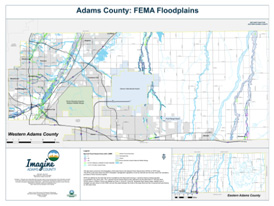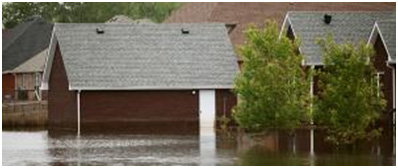 Adams County Facts
Adams County Facts
Three types of flooding that can occur in Adams County are: flash flooding, river flooding and dam failure flooding. The South Platte River Basin, which runs through western Adams County, periodically floods when snow runoff in the tributary streams combines with intense rainstorms. These types of intense rainstorms occur between May and August and are a major cause of flooding in the county. The most frequent flooding events are quite localized in nature, resulting from heavy rains over urbanized areas that are not able to appropriately handle storm water runoff.
Dams
Adams County has 36 dams located within the county. While dam failures are unlikely, it should be noted that the conditions of private dams are unknown and not subject to building standards which may lead to poor structural conditions and contribute to a dam failure.
Dam failure floods are primarily a result of hydrologic or structural deficiencies and can also occur when the dam is overtopped as a result of large waves generated from landslides into a reservoir or a sudden inflow of water from upstream dam failures. Dam failures typically occur with little warning and, depending on the size of the dam and the inundation area, the damage could be catastrophic.
Flash Floods
Almost all recorded floods on the South Platte River have been generated near the river’s headwaters on the slopes of Monument Divide. Past floods have resulted from snowmelt and intensive rainstorms over the mountain and eastern streams. Most flash flooding is caused by slow-moving thunderstorms in a local area or by heavy rains associated with hurricanes and tropical storms. Although flash flooding occurs most often along mountain streams, it is also common in urbanized areas where much of the ground is covered by impervious surfaces. Urbanization and lack of stormwater drainage often leads to flooding of roadways during storm events. Adams County currently monitors these areas and has noted that they are proactive in clearing the areas and closing the roads.
Hazard Description and Concerns
Generally, floods are long-term events that may last for several days. The primary types of general flooding include riverine, coastal and urban flooding. Riverine flooding is a function of excessive precipitation levels and water runoff volumes within the watershed of a stream or river. Urban flooding occurs where man-made development has obstructed the natural flow of water and decreased the ability of natural groundcover to absorb and retain surface water runoff. Sudden melting of snowpack can result in significant flooding.
Flash floodwaters move at very high speeds—“walls” of water can reach heights of 10 to 20 feet. Flash floodwaters and the accompanying debris can uproot trees, roll boulders, and damage or destroy buildings, bridges and roads. Flash floods provide residents with little warning for evacuation and, if severe, can be deadly.
Flooding Safety Tips
Before: What would you do if your property was flooded? Are you prepared?
- Build an emergency kit and make a family communications plan.
- Determine how you and your family will receive information and warnings for flooding events. Preparedness starts with a mindset about staying aware.
- Avoid building in a floodplain unless you elevate and reinforce your home.
- Elevate the furnace, water heater and electric panel in your home if you live in an area that has a high flood risk.
- Consider installing "check valves" to prevent flood water from backing up into the drains of your home.
- If feasible, construct barriers to stop floodwater from entering the building and seal walls in basements with waterproofing compounds.
- •Educate children about the dangers of playing in and near ditches and drainage ways. While little or no water may run through drainage ways on a regular basis, it only takes six inches of fast moving water to whisk a child down-stream.
During: If a flood is likely in your area, you should:
- Listen to the radio or television for information.
- Be aware that flash flooding can occur. If there is any possibility of a flash flood, move immediately to higher ground. Do not wait for instructions to move.
- Be aware of stream, drainage channels, canyons and other areas known to flood suddenly. Flash floods can occur in these areas with or without typical warnings such as rain clouds or heavy rain.
- If you must prepare to evacuate, you should do the following:◦Secure your home. If you have time, bring in outdoor furniture. Move essential items to an upper floor.
- Turn off utilities at the main switches or valves if instructed to do so and if there is time. Disconnect electrical appliances. Do not touch electrical equipment if you are wet or standing in water.
- If you have to leave your home, remember these evacuation tips:◦Do not walk through moving water. Six inches of moving water can make you fall. If you have to walk in water, walk where the water is not moving. Use a stick to check the firmness of the ground in front of you.
- Do not drive into flooded areas. If floodwaters rise around your car, abandon the car and move to higher ground if you can do so safely. You and the vehicle can be swept away quickly.
- Do not camp or park your vehicle along streams, rivers or creeks, particularly during threatening conditions.
After: When flooding has ended, remember to:
- Use local alerts and warning systems to get information and expert informed advice as soon as available.
- Avoid moving water.
- Stay away from damaged areas unless your assistance has been specifically requested by police, fire, or relief organization.
- Emergency workers will be assisting people in flooded areas. You can help them by staying off the roads and out of the way.
- Play it safe. Additional flooding or flash floods can occur. Listen for local warnings and information. If your car stalls in rapidly rising waters, get out immediately and climb to higher ground.
- Return home only when authorities indicate it is safe. Have a qualified technician on scene to turn on power and gas.
- Roads may still be closed because they have been damaged or are covered by water. Barricades have been placed for your protection. If you come upon a barricade or a flooded road, go another way.
- If you must walk or drive in areas that have been flooded, stay on firm ground. Moving water only 6 inches deep can sweep you off your feet. Standing water may be electrically charged from underground or downed power lines.
- Flooding may have caused familiar places to change. Floodwaters often erode roads and walkways. Flood debris may hide animals and broken bottles, and it's also slippery. Avoid walking or driving through it.
- Be aware of areas where floodwaters have receded. Roads may have weakened and could collapse under the weight of a car.
- Stay out of any building if it is surrounded by floodwaters.
- Use extreme caution when entering buildings; there may be hidden damage, particularly in foundations.
- Avoid floodwaters; water may be contaminated by oil, gasoline or raw sewage.
- Service damaged septic tanks, cesspools, pits and leaching systems as soon as possible. Damaged sewer systems are serious health hazards.
- Listen for news reports to learn whether the community’s water supply is safe to drink
- Clean and disinfect everything that got wet. Mud left from floodwaters can contain sewage and chemicals.
- Turn off the electricity at the main breaker or fuse box, even if the power is off in your community. That way, you can decide when your home is dry enough to turn it back on.
- Get a copy of the book Repairing Your Flooded Home (737KB PDF) which is available free from the American Red Cross or your state or local emergency manager.
To see the full list of disaster preparedness tips for floods, please visit www.ready.gov/floods.





